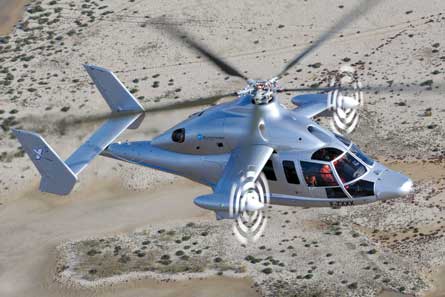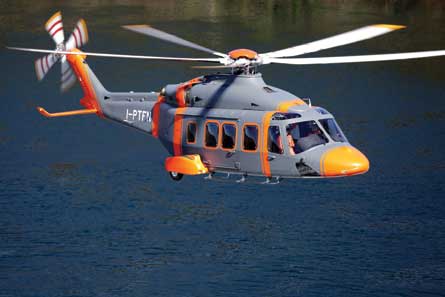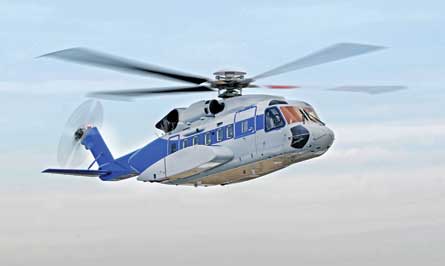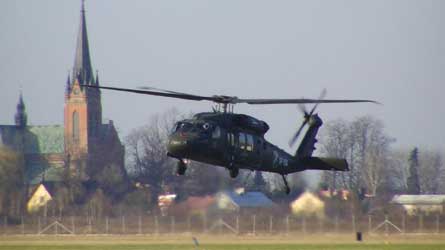As helicopter manufacturers slowly return to growth, they face new challenges presented by government budget cuts in the traditional markets of Europe and North America. At the same time, investment is needed for new developments, such as overcoming the central disadvantage of rotorcraft: slow speed.
A main objective for the USA's Bell Helicopter is to "regenerate its influence in the commercial market" and balance out its current 60:40 sales split between military and civilian customers, reports Larry Roberts, senior vice-president commercial business.
The Forth Worth-based company held "upwards of 45-50%" of the civil helicopter market around 25 years ago, says Roberts. "[But] over the course of time, because of significant investment in the military side, the commercial side has suffered and lost market share."
Today the manufacturer holds around 20% in each segment on the global market, but with governments in North America and Europe cutting defence budgets, the commercial business has to pick up the shortfall.
 |
|---|
Eurocopter |
Eurocopter's X3 hybrid helicopter demonstrator will be seen in flight by the public for the first time at Paris |
Additional revenue is also to come from aftermarket support in future. A year ago, the Textron subsidiary opened a maintenance and completions centre in Prague, and its Singapore facility is being expanded. The company is looking to increase its footprint in Asia and potentially establish a site in South America.
At the Paris air show, it will present the latest variants of its turbine single 407 series: the civil 407GX featuring a Garmin G1000HTM glass cockpit and the military 407AH, which can be configured with weaponry and surveillance equipment.
Roberts admits the company needs to launch new models to support its growth ambitions. "It is very difficult to compete in the commercial sector if you don't look to the future and develop new products."
CLEAN SHEET
Bell revealed in January a clean-sheet development programme called Magellan, but Roberts cautions against hoping for more information at Le Bourget. "We will not be able to talk in detail about any new products."
The airframer aims to grow its overall market share between 5% and 7% over the next three to five years. However, while the company sees signs for an industry recovery, it does not expect a return to stable growth soon. "There is still uncertainty," says Roberts. "The next two years will be critical as to how we move into the future based on global opportunities."
Eurocopter, meanwhile, plans to display its X3 hybrid helicopter demonstrator in flight to the public for the first time at Paris. The experimental aircraft is based on the Dauphin medium twin helicopter, but equipped with two side-mounted, main engine-driven propellers as well as a new, tail rotor-less empennage. It is undergoing flight testing and reached a temporary airspeed of 232kt (430km/h) in level flight in May.
High speed, however, is not the exclusive target for the programme. The objective is to increase speed by 50% while keeping lifecycle costs at 20-25% above conventional helicopters. "We are not in a race for speed, we are in a race for productivity," says Eurocopter president Lutz Bertling. "We really want to come up with a solution, which gives comparable speed to a tiltrotor but at much lower cost."
The manufacturer wants to launch a research and development programme with other equipment manufacturers at Le Bourget, which will lead to a "different way of flying a helicopter" and for which the first application will be the planned Dauphin replacement X4, reports Bertling. Whether that will involve the X3 rotor-propeller architecture, however, is not yet clear, he adds.
The main business challenge in the short term is how the North American and European markets will recover after the 2008 downturn. While Bertling generally sees flight activity and the number of sale offers going up "strongly", there is new uncertainty given defence budget cuts on each side of the Atlantic.
US IMPACT
He does not expect a heavy impact in the USA, thanks to an ongoing UH72A Lakota contract with the army and potentially new deals for armed scout helicopters for the army as well as the common vertical lift support programme for the air force.
The situation in Europe, however, is "a bit more tricky", says Bertling. "We have not seen impacts on our programmes yet, but I am not sure that there will not be some coming up."
 |
|---|
© Bell |
Bell 407AH |
AgustaWestland is likely to present its new chief executive in Paris. Previous post holder Giuseppe Orsi has been appointed to head parent group Finmeccanica, and is being replaced by AgustaWestland's former chief operating officer Bruno Spagnolini.
The Anglo-Italian manufacturer displayed its youngest commercial development, AW169, at Heli-Expo in Orlando, Florida in March. The 4,000kg (8,800lb) twin-engined helicopter is scheduled to lift off for its first flight in 2012 and enter service at the end of 2014. Thus far, the development of the light intermediate category helicopter is progressing "as planned", says the airframer.
On the military side, the company is working on the intermediate twin AW149, but suffered a setback when Turkey selected the competing Sikorsky S-70i Black Hawk as a general-purpose helicopter in a 109-aircraft deal.
 |
|---|
© Augusta Westland |
AW149 |
AgustaWestland had hoped an agreement could be reached following a previous contract for 60 AW129-based attack helicopters for the Turkish army. Those T129s are assembled by Ankara-headquartered Turkish Aerospace Industries and equipped with avionics and mission equipment by Aselsan.
A similar co-operation was planned for the AW149 deal. Nevertheless, AgustaWestland wants to continue the development, foreseeing a market for up to 8,000 medium category helicopters over the next 35 years.
Le Bourget will see the first public appearance of Sikorsky's CH148 Cyclone, a derivative of the S-92 twin-engined medium-heavy helicopter, which has been developed for the Canadian forces. Sikorsky will also show the S-70i Black Hawk, but its high-speed X2 technology demonstrator with twin coaxial contra-rotating main rotors and a pusher propeller at the tail, will not be on display.
The novel architecture will be employed on the planned S-97 Raider, which is to be offered to the US Army as a future scout and attack helicopter. A preliminary design review for the aircraft - which will be about 30% larger than the X2 - is planned for this summer, with component fabrication to start next year. The first flight and beginning of US military evaluation is scheduled for 2014.
 |
|---|
© Sikorsky |
Sikorsky S-92 |
Sikorsky is bracing itself for a declining US defence market while looking for new opportunities elsewhere. "We expect our government business to level off after the significant ramp-up of the past several years," says Joe Gigantelli, vice-president for Europe, the Middle East, Turkey and Africa. "We are focusing more on increasing our international military business, aftermarket sales and commercial aircraft business."
 |
|---|
Sikorsky |
Now made in Poland: the Sikorsky S70i Black Hawk has been selected by Turkey |
In 2010 the manufacturer agreed with Mubadala Aerospace to establish an $800 million MRO complex for fixed- and rotary wing aircraft named Advanced Military Maintenance, Repair and Overhaul Centre at Al Ain airport in Abu Dhabi. Lockheed Martin has joined the project, which aims to create 4,000 jobs and reach customers as far away as south Asia.
Watch footage of Eurocopter's X3 hybrid helicopter demonstrator in flight
Source: Flight International























